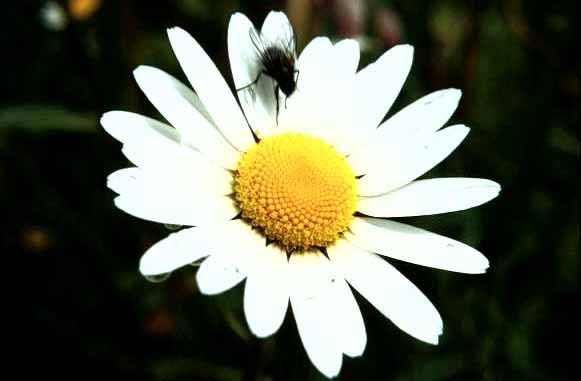
Flowers are to the background green
of meadow and forest what a poem is
to the constant chatter of sounds which
surrounds us. How strikingly beautiful
they are, these centers where essences
converge
A Daisy of Dry Meadows

|
Flowers are to the background green of meadow and forest what a poem is to the constant chatter of sounds which surrounds us. How strikingly beautiful they are, these centers where essences converge |
for Max
We count the rays, knowing
that the metamorphosis
of plants is also our own,
clear centers which turn
around the great play
of loss and rebirth.
Pray for just 10 more days of summer.
Hay cut, carefully dried, put up
in the winter barn.
Work finished, the farmer
knows what the philosopher
only longs for—
No stone, but a song
which snaps shut resolutely,
without a thought,
leaving plenitudes of questioning
silence between so many
unnamed stars and the
snows which are sure to fall.

(Photo: Meadow Daisy; (Chrysanthemum leucanthemum) Above
1,100 meters, a signature species for
small meadows which are traditionally mowed by hand twice a year, and which
receive a dressing of well-
composted cow and sheep manure but once in the fall. (To view this
particular daisy in situ, or
in the meadow where it actually was growing, click on photo.))
In Alps of Europe, Oxe-eye Daisies are to this day called Margerietli,
the same name
of the character in Goethe's Faust who recites the children's rhyme, "He
loves me,
he loves me not." while plucking one by one the flower's beautiful white
ray florets.
Though not native to North America, the same species, growing in dry wayside
places but with much smaller flowers, can occasionally be found there.)
| go to
Picture/Poems: Central Display | go to
Week VII: PicturePage |
|
Map
|
TOC:
I-IV |
TOC:
V-VIII |
Image Index
|
Index
| Text Only
| Download
Page |
Newsletter
|
About
P/P |
About Cliff
Crego
|
Copyright © 1999 - 2002 Cliff Crego All Rights
Reserved
(Created:
IV.7.1999; Last update:
III.4.2002)
Comments
to
crego@picture-poems.com